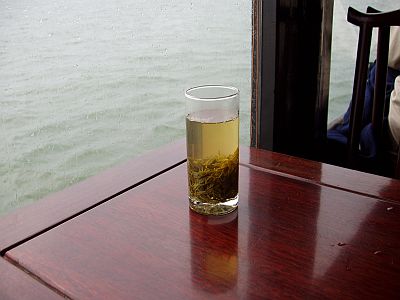

A rare sight: A glass of Tai Lake tea served on our on our "tourist boat", on Tai Lake
In China, a transparent (water size) glass is often used to hold Biluochun, and many green teas in China, making it easy to see the shape of the leaves and the color of the liquid. On the boat trip and at our conference in the Tai Lake hotel, servers walked around with hot water thermoses, and refilled the tea glasses, pouring the water over the unfurling tea leaves many times. (This was so common that I almost forgot to mention it, as we took it for granted!)
A description of the tea states "Biluochun is a whole leaf (bud) green tea that is conventionally made in the cup (& often glass). Its natural sweetness and fragrance allows for this. Prepared in a glass, the effect is quite charming. The floss disperses & the curly pale green buds unfurl and begin to bob up and down the infused tea. The buds eventually swell displaying their pre-harvest form before falling upright to the bottom of the glass. To make Biluochun well, a good quality soft mineral water, heated to about 75 deg. C, is necessary. A measured amount of tea is added to each glass and cooled water poured over the leaf. A bright yellow-green infusion envelops the glass within minutes & the green tea is ready for sipping with the help of the odd blow to push away floating buds."

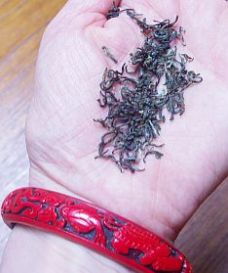
Biluochun has the natural quality of flower and fruit fragrance, its fragrance strong, its taste heavy, and its color bright. So it is labeled as "precious tea".
After our boat ride on Tai Lake, and conference banquet in Suzhuo, where we experienced the local tea, we went back to our Tai Lake hotel. The next morning our host, preparing for our bus trip to the high speed Maglev train ride to the airport
for our trip to Taiwan, suggested a stop at a tea shop. He knew we loved the Tai Lake tea.
So our bus took a long detour, and took us to a tea shop that specialized in the local Biluochun Tea. Here are photos of the teashop where we bought our tea.
At this shop, there were three grades of the fresh Spring harvest. The highest grade was very expensive. We chose the second grade which cost about $20. US for 3 oz. We were assured that it was very good, and it was wonderful. Now we wish we had bought a little of the highest grade to compare, and hopefully we will get some. Inside the shop, only Chinese was spoken, and our host, Hao Shen, explained the prices and grades to us. We were happy then to have been able to buy some tea, and even happier when we got home and had some.
It is delicious!
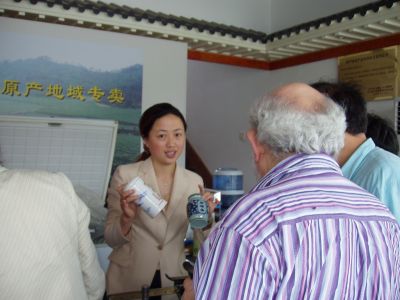
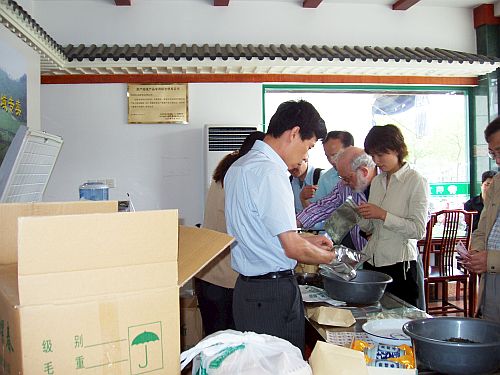
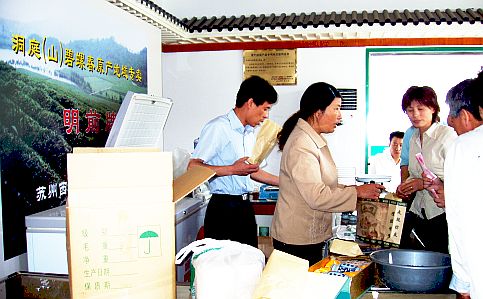
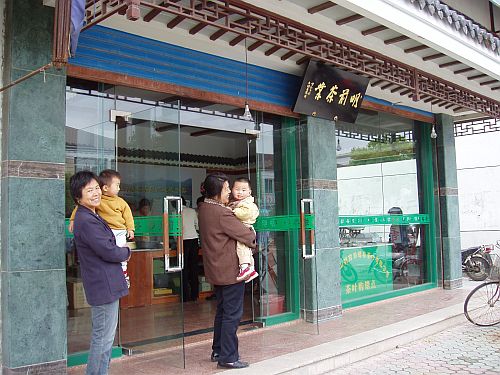
The front of the tea shop.
Suzhou 's Biluochun Tea is one of the ten most famous teas in China . It is locally known as "Fearful Incense" due to the strong aroma of the brew.
During the Qing dynasty, Emperor Kangxi visited Suzhou and praised the flavor of this aromatic tea. The tea leaves are picked from the Biluo Mountain near Tai Lake , and are collected traditionally in early spring between what is known as "Tomb-sweeping Day" and "Grain Rain Day"!
The technique for collecting tea leaves is very complex. Only the tender tip of the leaf is used for the tea making process. This part of the leaf should be no longer than one inch long and shaped like the tip of a spear. One tin of tea uses 60 thousand spears! It's no surprise then, that some of the finest Chinese teas are very expensive. The next step in the process is to repeatedly knead, rub and roll the leaves by hand. The Biluochun tea involves a particularly labor intensive process but the end result are leaves that are compact, tender and wonderfully fresh and aromatic.
Biluochun grows along the Tai Lake which occupies an area of about 2200 square kilometers. The Tai Lake, also called Lake Zhengze, is one of the five largest freshwater lakes. The lake has mists and ripples over it, and the water in it is very limpid. Su dongpo once wrote a poem about it: "I dreamed of boating on Zhengze, the white waves are flying to the sky." The East Hill of Dongting lies about 30 kilos southwest of Suzhou. It is a peninsula, sticking into the lake like a huge boat. Lying to its opposite, several kilos away, is the East Hill of Dongting. The west hill is an island standing in the lake, which is said to be the summer resort of Fuchai, the king of Wu in ancient China, and the queen Xishi. The two hills of Dongting, warm in winter and cool in summer, have mild weather, rising vapor and fresh air. The mists fill the whole hill. So it's very suitable for tea trees to grow there. The tealeaves of Biluochun are very delicate, so you must be very cautious in picking them. High-grade Biluochun can be first picked around Chunfen (about March 23), and the best time is about April 4. You must select the leaves as soon as you have picked them home, throwing away those old, big, and ill-colored ones. The three processes as picking, selecting, and refining must be done very carefully. The two similar tealeaves, if processed in different ways of refining, will have pronounced differences in quality. Biluochun is a high-quality, man-made traditional tea which has a unique flavor.
It grows in the Dongting Mountain along the Tai Lake in Wu County in southeast Jiangsu Province. Dongting has had a long history of producing tea, and is famous for it.
SOME STORIES ABOUT BILUO CHUN
1. It is said that there was a peak called Biluo on the East Hill of the Dongting Mountain. on the side of which grew several tea trees, and every year people came here and pick tea leaves to process them and then drink. One year, in the tea picking season, the local people tea leaves grow luxuriantly. They picked and picked, and there was too much to be held in their crates. So they put the rest in their clothes. As the fresh leaves were heated by the bodies, they spread out strong fragrance which made all the pickers shout, "It is surprisingly fragrant!" After that, nobody used crates to hold tea leaves; instead they all carry them on their chests and named these tealeaves "frightening fragrance"(meaning strong fragrance). Among the pickers was one called Zhu Zhengyuan who was proficient in processing "frightening fragrance". One year, Emperor Kangxi of the Qing Dynasty came sightseeing in the Tai Lake, and the official Song Luo presented "frightening fragrance" to the Emperor. The Emperor was very pleased with its taste, but disliked its name. So he renamed it as "Biluochun".
2.A local tells this story..."Taihu Lake region enjoys eight months of sunshine a year. Flowers, fruits
and crabs are in season all year round.
Usually, we have tea in our offices. At Xishan, we can enjoy tea at its
birthplace while listening to its story.
Long long ago, a beautiful girl named "Biluo" lived in Xishan. Her charming
singing-voice caught the attention of an evil dragon. Struck by Biluo's
beauty, the dragon decided to marry her. The girl was unwilling for she had
fallen in love with a handsome fisherman. The dragon threatened to flood the
village. To protect villagers, the man announced a war against the dragon.
They fought in the Taihu Lake for seven days. On the 8th day, villagers saw
the bodies of the dragon and the young man. They buried the man at a
mountain foot. The girl was sad at his death. She planted a tea tree in
front of his tomb and cried for seven days. She died on the 8th day.
The next spring, the tree sprouted leaves. Tea made from the leaves tasted
pure and smelt fragrant.
The villagers named the tea "Biluo chun" in memory of the girl."
3. Biluochun has a history of more than a thousand years. Originally it was called among the people “Dongting Tea” or “Scaring Tea.” It is said that a nun was once on her spring outing in the hill. She picked several of these tea leaves pan dried them and soaked them with boiled water. The striking fragrance made her blurt out, “Alas, what a scaring fragrance.” Hence the name, “scaring tea,” was handed down. Later, Emperor Kang Xi visited Taihu Lake on his inspection in the south. The governor of Jiangsu served the emperor with “Scaring Tea.” Kang Xi highly appreciated it, but he thought the name was not elegant enough. Since the tea was produced in Biluo Peak in Dongting East Hill, he called it “Biluochun.”
Go back to Our trip to China, May, 2005